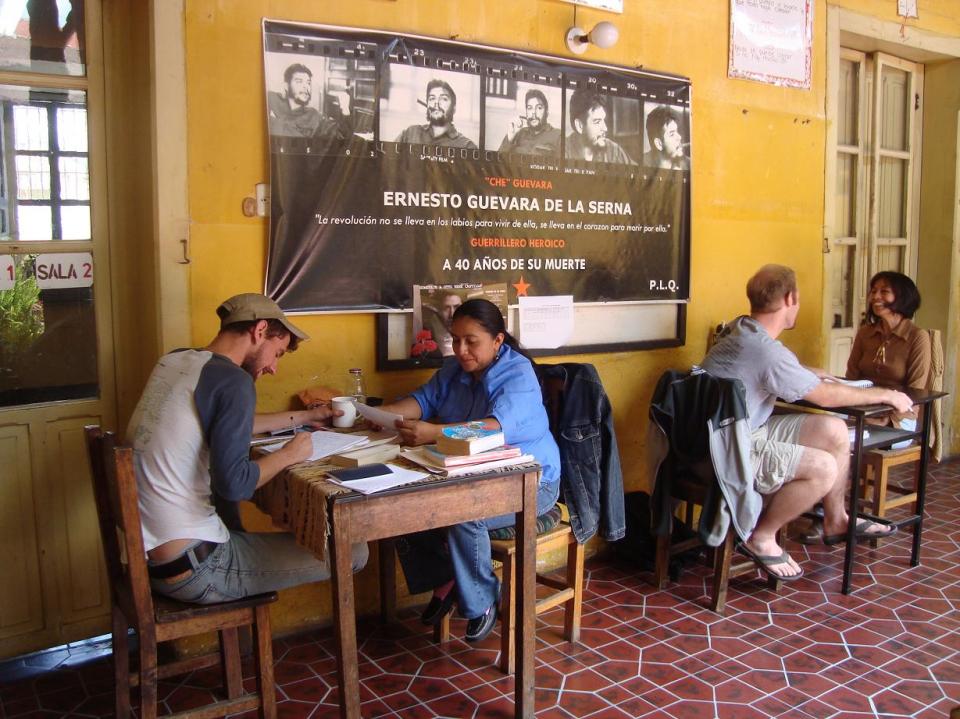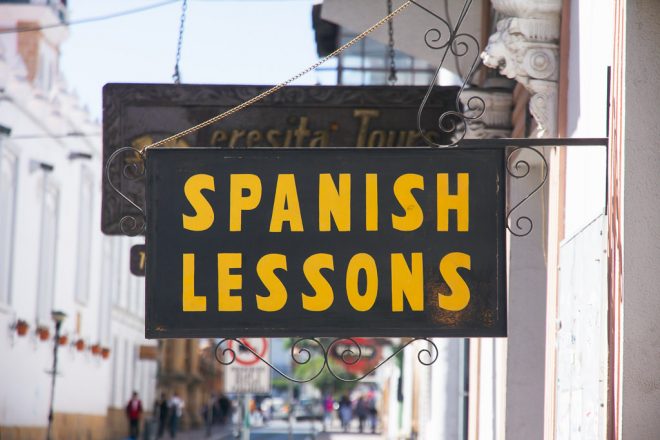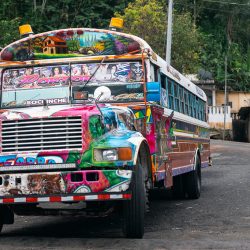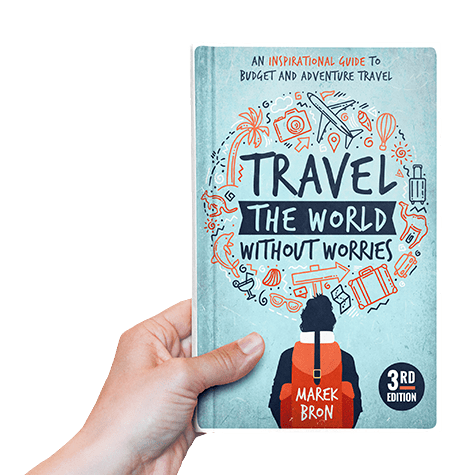English is so commonly spoken around the world that you’d almost get complacent. But if you expect it to be easy getting around with just English in South or Central America, then you may be in for a surprise.
Relatively few people in Latin America speak English as a second language. It’s even common for waiters, vendors, and even some tourist guides to only know Spanish, potentially creating much more of language barrier.
That means travelers may have a few more challenges to face!
Traveling Latin America without Spanish
Do you need Spanish in South America or Central America?
Well, it depends by how you define “need“.
While it’s very helpful to know some Spanish, surviving without it is entirely possible. You can even have a highly enjoyable trip without knowing the local lingo. If the language barrier is stopping you from going, just go!
On my first-ever trip to Peru, which was about ten years ago, I knew absolutely no Spanish and I was able to figure things out just fine. Along the usual tourist circuit, plenty of people do speak English, especially in hostels or hotels that are frequented by foreigners. (Just not random locals on the street.)
You can also still use hand gestures and other basic communication. Getting a WiFi password or asking when breakfast start is hardly rocked science; simply point at your phone, or point at a clock while making food-related gestures, such as circling around your tummy, with a quizzical look. Using Google Translate is also an option.
If just the thought of learning a new language makes you run for the hills, rest assured you won’t be completely lost without Spanish.
But it won’t give you the best experience…
Advantages of knowing Spanish
If you’re going to spend some time in Spanish-speaking countries, it does help to pick up at least a little bit of Spanish.
Obviously, just having the ability to ask for directions, exchange pleasantries, or negotiate prices will be extremely valuable.
You will also be seen less as a typical gringo tourist which means fewer attempts to rip you off and a generally more helpful attitude.
Better yet, if you advance to a basic level (even just A2 level of proficiency) you’ll be able to get to know many more locals.
When I travelled for a year through South America, I made it a point to learn some Spanish, and this got me invited to all sorts of local goings-on. I ended up at a 12-hour marathon BBQ in Argentina, someone’s graduation party in Colombia, and was invited for drinks in a small village in Peru.
Here’s how you can level up your Spanish before or during your trip:
How to learn Spanish for travel
1. Listen to audio courses
Chances are you’ll spend many hours on buses on your trip. This downtime is perfect for brushing up on your Spanish!
I used an audio course called the Michel Thomas Method. It’s a little old now so you can probably get a newer or better audio course elsewhere. Check out this playlist on Spotify with Spanish lessons. There are also many learn Spanish podcasts.

2. Take local classes
1-on-1 Spanish lessons are inexpensive in many Latin American countries.
A week of intensive lessons (usually 4 hours a day) costs as little as $100 in countries like Guatemala, Nicaragua, Peru, or Bolivia. Class-based lessons can cost even less.
A popular country to take lessons in Central America is Guatemala as the dialect there is quite pure and easy to learn. Nicaragua is a great option too and Mexico is nice as well.
In South America, a lot of people take classes in Bolivia because of the mild accent and low cost. Other countries like Peru, Ecuador, or Colombia are also popular options.
Many Spanish schools also offer homestay packages, where you stay with a local family for the duration of the course. This is a very fun way of learning Spanish but also finding cultural immersion.
3. Get a dictionary or language app
You’ve surely heard of Duolingo. It’s pretty great for learning the basics. Another one that I liked using was Babbel which teaches you the basics interactively as well.
During my first Central America trip I bought an old dictionary for a dollar in a hippie bookstore in Guatemala. This was fun to leaf through on some of my bus trips and because it was more tactile than an app, I think it really helped me memorize a lot of words.
4. Speak with everyone
Simply forcing yourself to interact with people and putting your learnings into practice right away will rapidly increase your comfort zone in Latin America.
Try to make some small talk with vendors for instance, or make friends with bilingual locals. Even if you stumble through your sentences, the effort is usually appreciated. You can also decide on doing some volunteering during your trip in order to have more regular interactions with Spanish-speaking locals.
5. Go to language exchanges
Finally, language exchanges can be an opportunity to learn but also can be a fun travel activity in their own right.
Bars or hostels will sometimes organize language exchanges, which you can find advertised on chat groups or on notice boards.
These language exchanges are often an excuse for travellers and locals to mix and have some drinks, while also practicing the language. It can be a little weird, but try to get into a conversational mode where you only speak Spanish and the other person only speaks English, as that way both parties will benefit most.
How much Spanish should you know?
Honestly, as much as you can bring to the table. That can be a little or a lot depending on your dedication and/or the length of your trip.
One of my travel buddies spent a year travelling around Latin America without knowing any Spanish at all. He managed just fine. For a while, it seemed the only word he knew was “necessito” (meaning “I need”). He would say it followed by the English word for whatever he wanted. Necessito water! Necessito food! Necessito toilet paper! Rest assured, he lived to tell the tale. Eventually picked up the local words as well.
Of course, knowing only the bare basics won’t get you as close to the culture, so it’s worth downloading Duolingo or booking a class to achieve a more immersive experience in Latin America.
Some links may be affiliate links, meaning I may earn commission from products or services I recommend. For more, see site policies.







Love your post! I started learning Spanish on youtube channels. I really like Andres from Spanishlandschool and also with the audio courses that you mention. But I ended up taking a traveling classroom which I can higligh recommend (www.spanishtravelclasses.com)
You can travel and learn Spanish at the same time
Great post. Check out my journey learning Spanish on the road in Central America. It’s amazing with so much to see and do. Take care
Go live and Travel. Learning Spanish in Central America
Hi, I know its an old post but for folks just arriving I found a couple of schools are no longer around and the price was excellent in Colombia. I had a look in Cali but no luck so ended up doing 4 weeks in Medellin at Total Spanish.
https://totalspanishcolombia.com/spanish-lessons-medellin.html
It was really very good and I also fell in love with the city.
Planning to study again in Mexico so if I do I’ll post back with my findings.
Nice post! Some good tips, learning Spanish in Latin America has been one of the best things I’ve done in my life! I also wrote a post with some other tips that worked really well for me…
https://mindmaker.wordpress.com/2016/11/07/learn-spanish-travelling-latin-america-free/
Dont forget to get a phrases app…
https://play.google.com/store/apps/details?id=com.mobincube.spanish_frasebook_by_maxi_deia_for_all.sc_3QZLB9&hl=es
Love your website! Thanks for the great tips shared! 🙂
I’m probably going to base myself in Antigua, Guatamala, can anyone recommend a spanish school there?
Hi Karen, many offers are available for you, I humbly submit our School for your consideration: http://www.intercoined.com/guatemala/antigua
Whichever school your attend, I hope you enjoy your stay!
Regards,
M.
Did you take any classes in South America? I’m researching the best places to learn for a new series of posts on my site, wwwbackpacksouthamerica.co.uk, so if you did I’d love to speak to you about the experiences! Please let me know 🙂
Great post. I agree you can’t beat real world conversation with Spanish speakers as a learning tool. For apps/online option, duolingo is a great free option as well.
Thank you for promoting the Spanish Language Learning. Getting private Spanish lessons is indeed cheap in South America. But prices can be very different from one country to another. For instance, the price for a week (7 days) at our language school in Granada, Nicaragua including 20 hours private lessons and homestay will cost you around a third of what a Spanish school with the same high standards will charge you in Costa Rica.
Great post, great info, I’m 100% proficient in Spanish so I’m happy to know my life will be much easier and I might even get cheaper deals.
As I start my dive career, I’m wishing I would have kept learning my languages. I know it’ll be easier to pick up once I start again, but I just need to do it! Thanks for the advice Marek!
Great post. One of my favourite as I love learning foreign languages. I actually studied Spanish at the university for 3 years (basic level) so I would love to speak it once again when in Latin America. I would recommend Rosetta Stone programme to pick up some basics. I’m studying Dutch right now and this is a great help for me.
Heard some great things about Rosetta Stone as it’s very interactive. Quite possibly a better option than audio lessons if you can afford it.
Good luck learning Dutch (it’s very cool that you are!). It’s my mother tongue but I’m told it’s relatively difficult to learn as a foreigner.